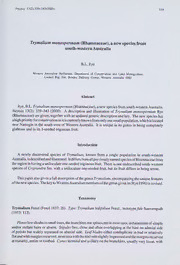
Trymalium monospermum (Rhamnaceae), a new species from south-western Australia PDF
Preview Trymalium monospermum (Rhamnaceae), a new species from south-western Australia
Nuytsia 13(2):339-343(2000) 339 Trymaliummonospermum (Rhamnaceae),anewspeciesfrom south-westernAustralia B.L.Rye Western Australian Herbarium, Department of Conservation and Land Management, Locked Bag 104, Bentley Delivery Centre, Western Australia 6983 Abstract Rye,B.L. Trymaliummonospermum(Rhamnaceae),anewspeciesfromsouth-westernAustralia. Nuytsia 13(2): 339-343 (2000). A description and illustration of Trymalium monospermum Rye (Rhamnaceae)aregiven,togetherwithanupdatedgenericdescriptionandkey. Thenewspecieshas ahighpriorityforconservationasitiscurrentlyknownfromonlyonesmallpopulation,whichislocated nearNarroginin the south-westofWestern Australia. Itis uniquein its genus in being completely glabrous and in its 1-seededtrigonous fruit. Introduction A newly discovered species of Trymalium known from a single population in south-western , Australia,isdescribedandillustrated. ItdiffersfromallpreviouslynamedspeciesofRhamnaceaefrom theregioninhavingauniloculateone-seededtrigonousfruit. Thereisoneundescribedsouth-western speciesofCryptandra Sm. with auniloculateone-seededfruit, butits fruitdiffers inbeing terete. ThispaperalsogivesafulldescriptionofthegenusTrymalium,encompassingtheuniquefeatures ofthenewspecies. ThekeytoWesternAustralianmembersofthegenusgivenin(Rye1996)isrevised. Taxonomy TrymaliumFenzl(Fenzl 1837: 20). Type: TrymaliumledifoliumFenzl., lectotype/h/eSuessenguth (1953: 113). Plantslowshrubstosmalltrees,thebranchletsnotspinescentinmosttaxa;indumentumofsimple and/orstellatehairs orabsent. Stipulesfree, close andoften overlapping atthebaseon adaxial side ofpetiolebutwidely separatedon abaxial side. Leafbladeseitherconduplicatein budorrelatively flatandwithmarginsrecurved,mosttaxawiththemidveinslightlyimpressedandthemarginsrecurved atmaturity,entireortoothed. Cymesterminalandaxillaryonthebranchlets,usuallyveryloose,with 340 Nuytsia Vol. 13, No. 2 (2000) fewtomanypedicellateflowers, occasionallysomecymesreducedto asingleflower;pedicelslong exceptinT. densiflorum. Floraltubeentirelyadnatetotheovaryanddiscoralmostso,notextended beyondthedisc. Sepals5,prominentandpetalline. Petals5,smallerthanthesepals,spathulate,with thelaminacuppedaroundanantherinbud. Discprominent,moreorlesshorizontal,thick,formedinto anundulateringatfirst(with 5 lobesextendingoutwardsbetweenthe stamenbasesalternatingwith five lobes extending inwards), becoming broader and more uniformly circular in fruit but with 5 indentationsaroundtheoutsidewherethepetalsandstamensinserted,glabrousinmosttaxa. Ovary (2)3-celled. Style with (2)3 stigmatic branches orlonglobes, orless prominently 3-lobed. Fruita 3-celledschizocarpinmosttaxa,eithera2-celledschizocarpor 1-celledintheremainingtaxa,about halfto fully inferior, enclosed atthebaseorfor its full length in the floral tube, which either splits irregularlyfromthebaseupwardstorelease 1-3monocarps(fruitingcarpels)orforms threeregular longitudinalslitstoreleasethemonocarps;monocarp(s)coriaceoustocrustaceous,entire,indehiscent, with(2)3surfaces,allsurfacesortheinnerone(s)brownandminutelytoprominentlypatterned. Seeds withadarkenedbase,theremainderuniformlybrown-colouredorwithapaleborder;arilveryreduced to athin saucer-like structure, huggingthebaseofthe seedbutreadily detached, entiretodistinctly 3-lobed, translucent. Notes. Agenusof 15 speciesoccurring in southernmainlandAustralia, with 12 speciesendemic to thesouth-westofWesternAustralia,onespeciesendemictosouthernSouthAustraliaandtwospecies endemictoTheGrampiansinVictoria. RevisionofkeytoWesternAustralianTrymaliumspecies ThenewspeciesfallsintothesecondmaindivisionofthekeytoWesternAustralianspeciesgiven inRye(1996). Thisportionofthekeycoversthetaxawithaglabrousovaryandisrevisedbelowto includeT.monospermumandtocorrectalaterreferencetothefruitofT.ledifoliumFenzl. Intheprevious keyTrymaliumledifoliumwasdistinguishedfromT.elachophyllumRyepartlyonthebasisofitsfully inferiorfruit,butitwasrecentlyobservedthathalfofthefewfruitingspecimensofT. ledifoliumvar. ledifolium do not have fully inferior fruits like the other varieties of this species. One specimen (E.A. Griffin 6673)hasthefruitsvaryingfromaboutthree-quarterstoalmosthalfinferior. 1. Ovary (only summitvisible) glabrous. Fruitglabrous, partially orfullyenclosedin thefloral tube, which is usually alsoglabrous. 9. Leaves narrowly obcordate tobroadlyobtriangular, with margins flatorincurvedat maturity. Floral tube constrictedbelow apex infruit and extended slightly above the fully inferiorfruit. 10. Leavesentire,hairy. Fruitterete, 3-seeded T.urceolare 10. Leaves distally toothed, glabrous. Fruittrigonous,!-seeded T.monospermum 9. Leaves linearto oblong-elliptic, withmargins somewhatrecurvedto revolute atmaturity. Floral tube notconstricted in fruitand exceeded orequalled inlengthby the half-inferiortofully inferiorfruit. mm 11. Leaves2-5 long. Fruitc. two-thirdsinferior,erectorspreading, regularly dehiscentinto three equal parts. Monocarps coriaceous to brittle atmaturity; inner surface finely reticulate, notridged T.elachophyllum mm 11. Leaves 8-40 long. Fruitusuallyfully inferior(exceptin T. ledifolium var. ledifolium), pendulous, irregularly dehiscent. Monocarps very hardatmaturity; innersurfaceprominently ridged, with large deep lacunae T.ledifolium Rye, B.L., Trymalium monospermum, a new species from south-western Australia 341 TrymaliummonospermumRye,sp. nov. Plantae omnino glabrae; folia conduplicata, dentata; ovarium uniloculare; fructus trigonus, uniseminalis. Typus: Narrogin area [precise locality withheld], WesternAustralia, 15 July 1999, L.W. Sagel540, J.P. Pigott&E.B. Pigott{holo:PERTH05301661;iso:CANB,K,MEL,NY). Shrubs0.1—0.3 mhigh andupto0.5 mwide, multi-stemmedatbase, notspinescent, completely glabrous. Youngstemswithminutetubercles,becomingdarkgrey. Stipulesovateorbroadlyovate, 0.7-1 mmlong,acuteorshortlyacuminate,entireorsomewhattoothed. Petiolec. 0.5mmlong. Leaf bladesconduplicateorwithmarginsincurvedatfirst,becomingflatornearlyflat,narrowlyobcordate tobroadlyobtriangular,5-8x2—4.5mm,entireinthebasalpartanddentatedistally ratherprominently , 2-lobedatapexwithatriangularmucronulatesub-lobeorapointatthejunctionofthetwomainlobes, eachofthemainlobesusually2—5-denticulatebutsometimesjustwithasinglemucronulatetip;upper surfaceminutelyreticulate-pitted;lowersurfaceminutelyrugosewithfurrowsandpits. Flowerscream oroff-white. Cymesterminalandaxillaryonthebranchlets,mostly5-12-flowered,veryloose,upto 14mmlonginfruit,notincludingthepeduncle,whichisuptoc. 6mmlong. Pedicels 1-1.5mmlong inflowerandupto4mmlonginfruit. Floraltubec. 0.5 mmlonginflower,enlargingtoc. 2.6mm longinfruitandbecomingconstrictedjustbelowthesummitwhichformsaspreadingterminalportion c.0.15mmlong. Sepalsc.0.8mmlong. Petalsc.0.4mmlong. Discc.0.25mmwide. Ovary3-celled. mm Stylec. 0.2 long; apexwith aflattened3-lobed stigma. Fruitfullyinferior, 1-celled, trigonous, mm truncate-obovateinoutlineand6-7x3.5^1 includingthefloraltubeandotherattachedparts,the floral tube splitting irregularly from the base upwards to release the single monocarp; monocarp equilaterally triangularin cross-section with each ofthe three surfaces obovate to elliptic, c. 2,4 x I.4mm,brown,coriaceous,veryminutelyreticulate-pitted. Seedc. 1.7x1mm,mediumorange-brown withadarkenedbase; aril 3-lobed,clear-translucent. (Figure 1) Otherspecimens examined. WESTERN AUSTRALIA [precise locality withheld]: Narrogin area, 29Aug. 1997,G.J.Keighery<£N. Gibson2088;Narroginarea, 15July 1999,L.W.Sage1541 & 1542, J.P. Pigott&E.B. Pigott. Distribution. OccursintheNarroginareaintheSouthWestBotanicalProvinceofWesternAustralia. Habitat. Recorded in red-brown gravelly sandy soil on a lateritic ridge, in a low heath vegetation includingMelaleucapungens,anumberofmembersoftheProteaceaesuchasDryandraarmata,and twoAllocasuarina species. Phenology. FlowersandyoungfruitsrecordedinJuly, andmaturefruitsinlateAugust. CALM Conservationstatus. ConservationCodesforWesternAustralianFlora;PriorityTwo. Known from asinglesmallpopulation, locatedonanaturereserve. When surveyedinDecember 1999, the populationcomprised28plants (Kim Kershawpers. comm.). Searches innearby areas ofbushland failedto locate anyfurtherpopulations ofthespecies (Leigh Sagepers. comm.). Etymology. FromtheGreekmono-one,andsperma-seed,referringtothe 1-seededfruit. 342 Nuytsia Vol. 13, No. 2 (2000) Figure 1. Trymalium monospermum. A -fruiting branch (xl), B -stipules and undersurface of leaf(x6); C - upper surface ofleaf (x6) with enlargement ofreticulate pitting; D - top and side view of fruit (monocarp enclosed in floral tube) and pedicel (x8); E - floral tube splitting at base to reveal monocarp (x8), F - monocarp (xlO), G - seed with basal aril (xlO). Drawn from G.J. Keighery & N. Gibson 2088. Notes.ItsclosestrelativeappearstobeTrymaliumurceolare(F.Muell.)Diels,whichissimilarinhaving conduplicate leaves, completely glabrous flowers, the floral tubeconstricted near the summit and a completely inferiorfruit. Trymaliummonospermumisaverydistinctivespecies,apparentlythesmallestmemberofitsgenus andtheonlyonetobecompletelyglabrous, andisreadilyidentifiedbyitsmoreorlessobcordateto obtriangularleaves with two large tooth-like orprominently denticulate lobes. Also uniqueto this species are the flattened stigma and 1-celled trigonous fruit with a solitary seed. Although T. monospermum has a 3-celled ovary with an apparently fertile ovule in each cell, only one cell develops into amonocarp, the twoabortedcells noteven being visible in the mature fruit. All other species of Trymalium have a terete fruit with more than one monocarp. Apart from T.floribundum Steud. subsp.floribundum, they all have a stigma with three long lobes, and three unequally3-facedmonocarps. Eachmonocarphas aroundedoutersurface, whichislargerthanthe twoflatterinnersurfaces,andtheinnersurfacesaremoreprominentlypatternedthantheoutersurface. InT.floribundumsubsp.floribundumtheovaryis2-celled,thestigma2-lobedandeachmonocarphas aroundedoutersurfaceandflatter,moreprominentlypatternedinnersurface. Alogicalexpectation fora 1-celledfruitinTrymaliumwouldbeforittohaveasingleroundedsurface,i.e.tobeterete,since thesolitarymonocarphasnointernalsurfacesadjacenttoothermonocarps. Insteadthemonocarpof Trymaliummonospermum istrigonous,withthreesurfacesofuniformshape, sizeandpatterning. Rye, B.L., Trymalium monospermum, a new species from south-western Australia 343 Acknowledgements IwouldliketothankLeighSageforbringingthenewspeciestomyattentionandforhisfieldwork, includingthecollectionoffloweringmaterial,alsoKevinThieleandJudyWestfortheirconstructive comments,PaulWilsonfortranslatingthediagnosisintoLatin,andMargaretPieronifortheillustration ofthenewspecies. References Fenzl,E. (1837). Rhamneae. In: Endlicher, S.L.,Bentham,G., Fenzl,E. &Schott,H.“EnumeratioPlantarum....Hiigel.” pp. 20-27. (Beck.) Rye,B.L. (1996). Asynopsisofthe generaPomaderris, Siegfriedia, Spyridium and Trymalium (Rhamnaceae) in Western Australia. Nuytsia 11: 109-131. Suessenguth, K. (1953). Rhamnaceae. In: Engler, H.G.A. & Prantl, K.A.E. “DieNaturlichen Pflanzenfamilien.” Vol. 20d, pp. 7-173. (Duncker & Humblot: Berlin.)
